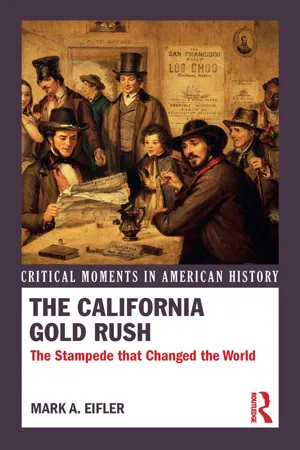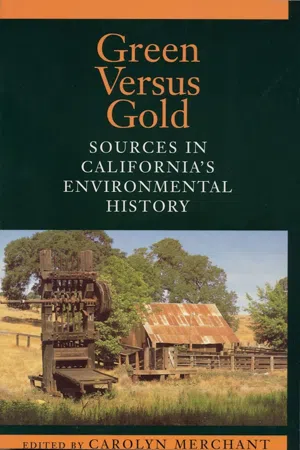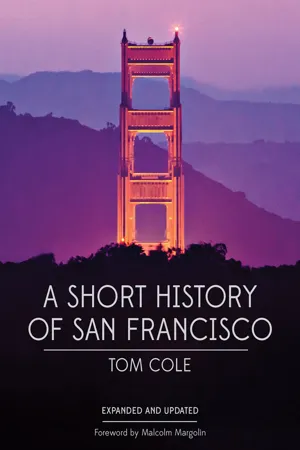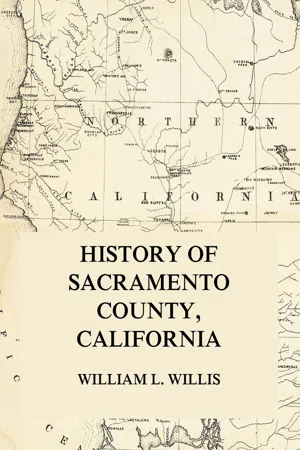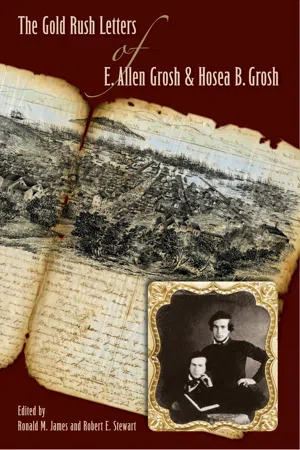California Gold Rush
The California Gold Rush was a significant event in American history that began in 1848 when gold was discovered at Sutter's Mill. This discovery led to a massive influx of people from around the world seeking their fortunes, resulting in a population boom in California and significant economic growth for the region. The Gold Rush had a lasting impact on the development of California and the United States.
6 Key excerpts on "California Gold Rush"
- eBook - ePub
Understanding American Icons
An Introduction to Semiotics
- Arthur Asa Berger(Author)
- 2016(Publication Date)
- Routledge(Publisher)
...The Gold Rush was primarily located in the area around a number of small cities such as Grass Valley, Nevada City, Truckee and Columbia in California. Columbia was originally called Hildreth’s Diggings, after Dr. Thaddeus Hildreth who discovered gold there. It later changed its name to American Camp and finally to Columbia. Most of Columbia burned down in 1854 and it was rebuilt in red brick. It is still an important tourist destination where visitors can take buggy rides and purchase mining gear to pan for gold in the Columbia State Historical Park. Visiting the Gold Country is an exercise in nostalgia for “the good old days” (which were not so good for most people) and can be seen as a form of time travel” that allows a momentary escape from the routines of everyday life. Tourism, whatever else it may be, has a touch of escapism that colors it. Although some 300,000 people, from all over the world, raced to California during the Gold Rush, it is estimated that 75 percent of the people who came in search of gold were from the United States and 15 percent from Europe. That leaves 10 percent—or approximately 30,000 people—from other countries such as Mexico, Chile, Australia and China. The Gold Rush started in 1848 and ended in 1855. Many of the people who rushed to California in search of gold had no idea about how difficult it is to mine for gold and had no notion of the problems they would face in staking out their territory and living from day to day. And so they left rather quickly—disappointed and discouraged—for the promise of California did not materialize, and they left with collapsed hopes. The American Indians who occupied the lands where the Gold Rush took place were greatly victimized. They were pushed off their land, the rivers they fished in were ruined by mining, and huge numbers of them died from diseases carried by the would-be miners...
- eBook - ePub
The California Gold Rush
The Stampede that Changed the World
- Mark A. Eifler(Author)
- 2016(Publication Date)
- Routledge(Publisher)
...CHAPTER 2 Deciding to Go T he gold rush of 1848 was local. Most miners came from California, Oregon, and northern Mexico. By the end of 1848, roughly 5,000 people had visited the mining region. As the year ended and the winter rainy season returned, most of these miners had gone home again. The number of prospectors at this point was roughly on par with the mining rushes in North Carolina and Georgia in earlier years, and even California’s earlier Placerita Canyon rush of 1842. Over the winter of 1848–1849, something new happened. The California Gold Rush “went viral.” It exploded from its local setting and became an international stampede. Hundreds of thousands of people, with no mining experience, gambled their lives and fortunes on a long and dangerous journey to the new “El Dorado.” A new illness seemed to sweep the nation: “gold fever.” Sufferers appeared obsessed with rumors and news from California, studied maps and guidebooks on ways to get there, and began planning how to leave for the West as soon as possible. Traditionally, the abundance and ease of mining gold in California accounts for this sudden rush, and these causes certainly cannot be ignored. President Polk and eastern US newspapers all seemed to confirm the availability and ease of mining at the end of 1848. Yet, ultimately, these explanations cannot explain the rush fully. At the beginning of 1849, the exact extent of mining could only have been guessed at; going to California was still a gamble. The rush continued strong for nearly a decade, long after it was clear that California’s gold could not be easily gathered from the surface, and even as the amount of gold being mined seemed to be diminishing. Nor could the real dangers of the trip be ignored, either in 1849 or for the following decade. Yet the “fever” continued...
- eBook - ePub
Green Versus Gold
Sources In California's Environmental History
- Carolyn Merchant(Author)
- 2013(Publication Date)
- Island Press(Publisher)
...1994. Robinson, Fayette, and Franklin Street. The Gold Mines of California: Two Guidebooks. New York: Arno Press, 1973. Rohrbough, Malcolm J. Days of Gold: The California Gold Rush and the American Nation. Berkeley: University of California Press, 1997. Smith, Duane. Mining America: The Industry and the Environment, 1800—1980. Lawrence: Kansas University Press, 1987. Williams, Stephen. The Chinese in the California Mines: 1848—1860. San Francisco: R and E Research Associates, 1971. Wyman, Mark. Hard Rock Epic: Western Miners and the Industrial Revolution, 1860—1910. Berkeley: University of California Press, 1989. Young, Otis E. Black Powder and Hand Steel: Miners and Machines on the Old Western Frontier. Norman: University of Oklahoma Press, 1976....
- eBook - ePub
- Tom Cole(Author)
- 2012(Publication Date)
- Heyday(Publisher)
...Frantic orders to Hawaii for supplies spread the word around the Pacific Basin. Peru and Chile, Hawaii, and Australia began to send prospectors. News traveled east, notably in the form of a “small chest called a caddy containing $3,000 worth of gold in lumps and scales,” carried by one Lt. L. Loeser. In November the caddy was temptingly displayed at the War Office in Washington, D.C. And, on December 2, President Polk, in his last message to Congress, gave the Gold Rush an official endorsement: “The accounts of gold in [California] are of such an extraordinary character as would scarcely command belief were it not corroborated by the authentic reports of officers in the public service who visited the mineral district, and derived the facts which they detail from personal observation.” Four days later, the New York Herald summed up the excitement, “The El Dorado of the old Spaniards is discovered at last.” “Gold Fever,” historian John Walton Caughey has written, “swept the Atlantic seaboard, jarred staid New England, coursed through the Ohio Valley, and up and down the Mississippi…spread to Canada, jumped the Atlantic to England, invaded the European continent and stirred France and Germany, the Baltic peoples, and the Mediterranean.” Along the way gold fever infected hundreds of thousands of farmers, students, loafers, shopkeepers, scoundrels, clerks, and solid citizens. But the spout of the funnel of this auriferous longing, the gateway to the diggings, namely the muddy village of San Francisco, was, in 1849, on the other side of the world—whatever side of the world one started from. Prentice Mulford, later an outstanding San Francisco literary figure, was living in the little Long Island town of Sag Harbor when the news came roaring in. During the long winter of 1848–49 there was talk of little else...
- eBook - ePub
- William L. Willis(Author)
- 2018(Publication Date)
- Jazzybee Verlag(Publisher)
...CHAPTER VI. THE DISCOVERY OF GOLD We generally speak of the discovery of gold in California as having been made by James Marshall at Coloma, in January, 1848, and while this is true in a practical sense, resulting in the stampede that brought adventurers from all over the world to this state, there is no doubt that the existence of gold had been known many years before. The first mention of gold in California is found in Hakluyt’s account of the voyage of Sir Francis Drake, who spent five or six weeks in June and July, 1579, in some bay on the coast of California, the locality of which has never been settled as to whether it was San Francisco Bay or one of those farther north. Hakluyt wrote: “There is no part of the earth here to be taken up wherein there is not a reasonable amount of gold or silver.” As neither gold or silver has ever been found in the vicinity of the point where Drake landed, Hakluyt’s story must be classed with other tales of the early explorers and as mere conjecture regarding an unknown land. However. other early explorers stated that gold had been found long before the discovery by Marshall and there is no doubt that the opinion existed that gold was to be found in California. The country had been explored by Spanish, Russian and American parties since the sixteenth century and was visited by Commodore Wilkes while on an exploring expedition in the service of the United States. Members of his party ascended the Sacramento river and visited Sutter at his fort, while others made explorations by land. James D. Dana, the author of several well-known works on geology and mineralogy, was the mineralogist of the expedition and journeyed by land through the upper part of the state. He says in one of his works that gold rock and veins of quartz were observed by him in 1842 near the Umpqua river, in southern Oregon; also, that he found gold in the Sierra Nevadas and on the Sacramento river, also on the San Joaquin river and between these rivers...
- Ronald M. James, Robert E. Stewart(Authors)
- 2012(Publication Date)
- University of Nevada Press(Publisher)
...The fabled Gold Rush had attracted tens of thousands, and the easy pickings were claimed or gone. Placer mining—using various means to wash soil and gravel to reveal the heavier gold—already dominated a broad swath of the Sierra foothills. Still, hard times would not deter the young men: as Allen wrote on January 5, 1851, “Health, youth, strong arms, and stout hearts, and two years experience. What more could we ask? We are in California!” They joined many others who now looked for evidence of underground ore, realizing that although these quartz deposits would require more work and investment, this was the most likely way remaining to gain wealth through mining. At the same time, the brothers constantly considered and often pursued other options. They tried raising livestock and farming. With hard work, agriculture could provide a living, but it seldom led to remarkable wealth. Finding the occupation a distraction from searching for gold, they returned to placer mining and pursuing quartz veins. Any one of the options they considered might have given them a comfortable, sedentary life, but none of the other possibilities ignited their imaginations like the allure of gold, which remained their primary focus. Pondering various inventions proved less of a diversion largely because they were always imagining devices that would make mining more profitable. Still, the brothers wrote that their placer digs kept them from developing models of the instruments they hoped to produce. Much of their intellectual energy was given to an improved sluice box for the washing of gold-laden soil. It is unclear whether they ever produced a successful prototype, but whatever the fate of the idea, it failed to yield the profit they had imagined...

